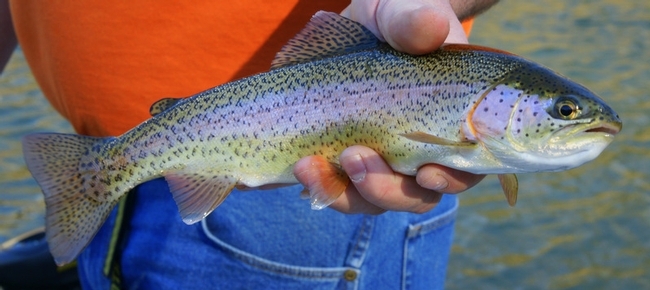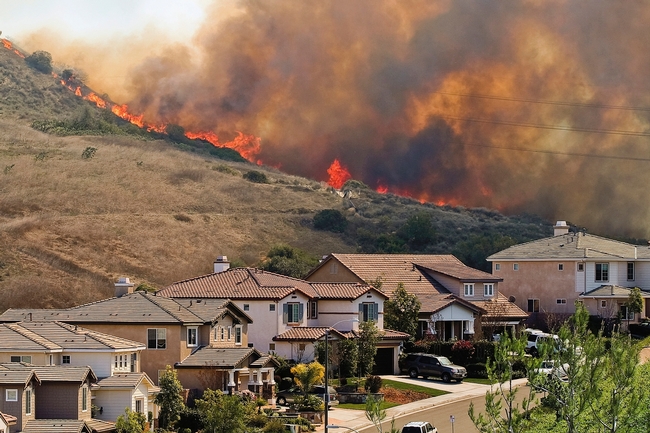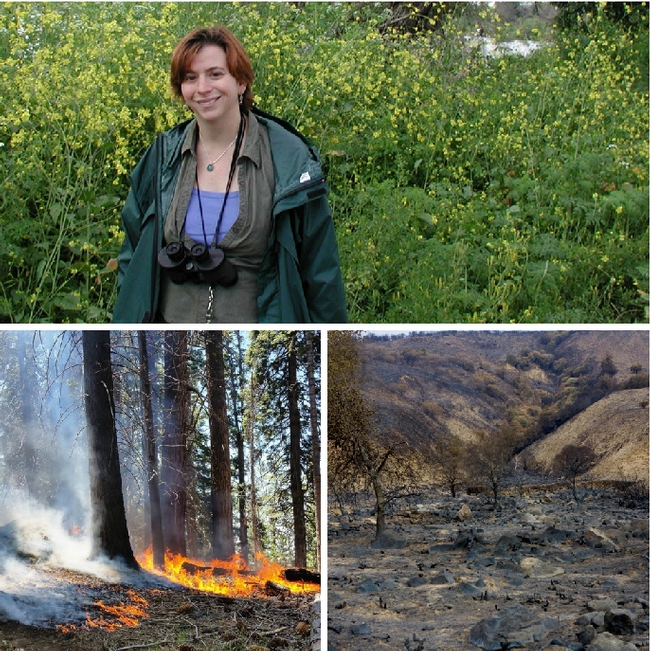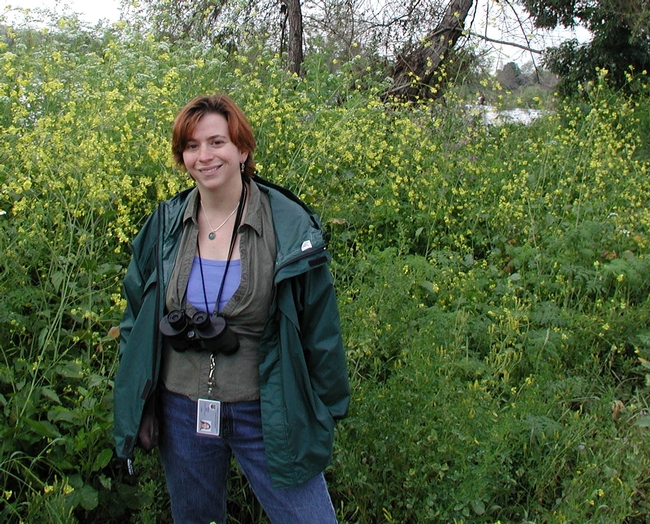Posts Tagged: Sabrina Drill
LA's concrete river revitalization unlikey to create habitat for steelhead trout
The city of Los Angeles is preparing to remove parts of the LA River's concrete lining, but that may not be enough to bring back native fish, reported Zoie Matthew in Los Angeles Magazine.
"It's hard to do piece-by-piece restoration projects for things adapted to river and stream systems. And it's impossible for steelhead," said Sabrina Drill, UC Cooperative Extension natural resources advisor in Los Angeles and Ventura counties.
Steelhead need a continuous, rapidly flowing channel to complete their life cycle. Other native fish, such as the Arroyo chub, will need gravel, plants, sediment and pools to be restored.
"Ecological heterogeneity is really important," Drill said. "Fish tend to need different kinds of habitat."
Warmer water temperature is another concern. The river lacks trees and plants to shade the water and concrete soaks up the sun's warmth, creating a habitat unsuitable for natives.
Drill said some of the new fish in the river have favorable characteristics. Mosquito fish help with pest control and carp make for good fishing.
"Part of (the river's) role is to provide low-income, underserved communities with a place to access nature, see native birds, and increase public health by having a safe area to walk and fish," Drill said. "I think there's value there too."
August 2018 News Clips 8/16-8/31
Enormous wildfires spark scramble to improve fire models
(Nature) Jeff Tollefson, Aug. 31
…“Something is definitely different, and it raises questions about how much we really know,” says Max Moritz, a fire scientist at the University of California, Santa Barbara.
… The problem, Moritz says, is that most of the fire models in use today are based on data from the past two or three decades. But it seems that fire behaviour might be shifting in response to climate faster than anybody expected, and that makes it increasingly problematic to extrapolate from past trends, he adds.
https://www.nature.com/articles/d41586-018-06090-0
Rodent control critical in subsurface alfalfa systems
(Farm Press) Todd Fitchette, Aug 31,
For alfalfa growers seeking other methods of rodent control, Dr. Roger Baldwin, Cooperative Extension specialist at UC Davis, says rodenticides, fumigants and trapping can be moderately to highly effective, depending on method and means used.
https://www.westernfarmpress.com/alfalfa/rodent-control-critical-subsurface-alfalfa-systems
Deeply Talks: Fire & Drought–The Extremes Become Routine
(Water Deeply) Matt Weiser, Aug. 30,
The American West has entered an era of permanent water scarcity, a marked shift from previous periods of episodic drought. The same can now be said for fire: In California, there hasn't been a month without a wildfire since 2012. Join us for a conversation about the ways in which water and wildfire management intersect, and about the West's adaptation to its new, and far from normal, reality. We'll be joined by experts Crystal Kolden, associate professor of forest, range, and fire sciences in the College of Natural Resources at the University of Idaho, and Van Butsic, cooperative extension specialist at the University of California, Berkeley. Email our community editor with questions for the panelists (lindsay@newsdeeply.com) or tweet us @waterdeeply using the hashtag #DeeplyTalks.
https://www.newsdeeply.com/water/talks/153877805
Deadly poultry ailment, Newcastle disease, reaches Ventura County
(Ventura County Star), Aug. 29
Maurice Pitesky, a veterinarian and University of California extension specialist in the School of Veterinary Medicine at UC Davis, said one of the challenges in keeping a lid on the disease is the continued popularity of raising backyard chickens.
“While people have the best intentions, unfortunately a lack of biosecurity practices in people's backyards is one of the contributing factors of the disease spreading,” Pitesky said.
The longtime head of the UFW is stepping down. His replacement will be the first woman to lead the union
(LA Times) Geoffrey Mohan, Aug. 28
At its heart, the UFW remains torn between whether it can be both a grass-roots union and a broad social movement operating in the halls of power, said Philip Martin, a UC Davis agricultural economist and farm labor expert.
...“It is worth noting that the UFW does not have union locals, and so therefore does not have a system under which current farmworkers are trained in leadership development with the idea that they will rise within the union,” he said.
http://www.latimes.com/business/la-fi-ufw-president-20180828-story.html
Expert Views: Managing Wildfires to Protect Water Resources
(Water Deeply) Lindsay Abrams, Aug. 28
Van Butsic, cooperative extension specialist at the University of California, Berkeley:
"Managing forest and wildfires to benefit water resources is difficult because there are trade-offs between short-term costs and long-term benefits. In the short term, wildfires can lead to increased erosion and sedimentation in streams and reservoirs. This contributes to lost revenue for downstream power generators and at times even requires water to be treated before it is potable."
Can Angelenos and Coyotes Coexist?
(LA Magazine) Henry Cherry, Aug. 27
…Intrigued by the animals, I stumbled across Coyote Cacher, an interactive website operated by University of California's Dr. Niamh Quinn. A native of Ireland, Quinn has been studying coyotes for about four years. “There are no coyotes in Ireland, but when I came here there was the need for coyote research in Southern California,” Quinn says. “There is a need for professional extension to the cities and the police departments, the people that never managed coyotes before but all of a sudden find themselves needing to do so.”
http://www.lamag.com/citythinkblog/coyotes-los-angeles/
Why homes are lost to wildfire — is yours as safe as it could be?
(Mercury News) Lisa Krieger, Aug. 27
…“When you start to understand why homes burn, often through embers igniting fuel in home attics or adjacent to homes, then it is easier to understand these patterns,” said Kate Wilkin, a fire specialist for UC Cooperative Extension.
Limiting suburban sprawl can ease the devastation of wildfires
(Mother Nature Network) Matt Hickman, Aug. 27
…But there's a bigger issue at hand. Max Moritz, a wildfire specialist with the University of California's Division of Agriculture & Natural Resources, relays to Martin Kuz of the Christian Science Monitor that inaction from state lawmakers who are reluctant to lead the charge in restricting development in vulnerable areas is only worsening the situation. Presently, local officials, developers and homeowners face few limitations when building in fire-prone wild land urban interfaces. Moritz refers to this as a “political will problem.”
What are GMOs?
(KYMA 13 On Your Side) Caitlin Slater, Aug. 27
Take a look in your refrigerator or pantry and you most likely find something with a NON GMO label on it.
13 On Your Side reporter, Caitlin Slater received an award at the annual Yuma County Farm Bureau meeting. The keynote speaker at the event was genomics and biotechnology researcher at UC Davis, Dr. Allison Van Eenennaam. She presented on how GMOs are actually better for us and our environment.
https://www.kyma.com/news/what-are-gmos-/786983339
Irrigation Tips to Mitigate Almond Hull Rot & Bark Damage
(Pacific Nut Producer) Aug. 27
The posting of this video is a little belated as almond harvest has already begun, but if you've had hull rot issues this season, be sure to watch this brief video interview with Nut Crops Advisor Mae Culumber as she provides some tips to prevent hull rot and trunk damage through better irrigation practices, as explained at a mid-July Nut & Vine Irrigation seminar at the UC Cooperative Extension office in Fresno. Read more about it in Pacific Nut Producer Magazine. Culumber will also be addressing almond growers at the Annual Grape, Nut & Tree Fruit Expo coming up on November 13th at the Big Fresno Fairgrounds, so be sure to attend!
http://www.pacificnutproducer.com/2018/08/irrigation-tips-to-mitigate-almond-hull-rot-bark-damage
Three Tips on Managing Pocket Gophers
(American Vineyard) Aug. 24
Pocket gophers can be very detrimental for growers, especially those with young orchards. So how do you minimize populations of these pesky critters? Watch this brief interview with Julie Finzel from the UC Cooperative Extension as she offers growers three quick tips for effective management. Julie will also be addressing growers on wildlife issues at the upcoming Grape, Nut & Tree Fruit Expo at the BIG Fresno Fairgrounds on November 13th, so be sure to attend. Learn more about it on AgExpo.biz.
http://www.americanvineyardmagazine.com/2018/08/24/three-tips-on-managing-pocket-gophers/
Master Gardeners: gardening in an age of climate change
(Napa Valley Register) Aug 24
This article is a summary of a seminar conducted by Susanne von Rosenberg, UC Master Gardener of Napa County, on gardening in an age of climate change.
Idea to Reduce Glyphosate Use with Grapes
(Cal Ag Today) Mikenzi Meyers, Aug. 23
John Roncoroni, a UC Cooperative Extension Weed Science Farm Advisor in Napa County, has made strides toward meeting this challenge. “Many times, growers will do two applications of herbicides during the year … but what I'm trying to do is push it back to post-leaf fall after the season to clean up and come back with a pre-emergent material right before bud break then maybe skip that last glyphosate treatment after bud break.”
https://californiaagtoday.com/idea-reduce-glyphosate-use-grapes/
California Today: The Human Element in California's Wildfires
(New York Times) Tim Arango, Inyoung Kang, Aug. 23
William Stewart, an expert on forestry at the University of California at Berkeley, said that part of the California dream was keeping “nature as it is,” with minimal management of forests.
https://www.nytimes.com/2018/08/23/us/california-today-fires-humans.html
Editing the Future of Aquaculture
(Hatchery International) Eric Ignatz, Aug. 23
…Dr. Alison Van Eenennaam, a cooperative extension specialist at the University of California, Davis, and a collaborator on the Recombinetics project, says that gene editing in the case of polled cattle is used to address an animal welfare concern. Typically, horns must be burned off to better protect the safety of farmers and other animals.
http://magazine.hatcheryinternational.com/publication/?i=517633&article_id=3159268#
Industrial hemp could be an alternative crop of the low desert
(Imperial Valley Press) Oli Bachie, Aug. 23
Hemp, Cannabis sativa L., is a dioecious annual plant that has not been grown legally in California for many years, due to regulatory restrictions.
UCSB SmartFarm uses cloud computing to help farmers increase sustainability
(Santa Maria Sun) Kasey Bubnash, Aug. 22
"They're basically taking what Google and the internet are doing with information and applying it to ag," said Beth Grafton-Cardwell, a research entomologist at UC Riverside. "And that hasn't really been done."
The Social Costs of Living in Wildfire-Prone Areas
(East Bay Express) Alastair Bland, Aug. 21
…"But that's so politically contentious — it's a line politicians walk up to but turn away from," said William Stewart, a UC Berkeley forestry and wildfire specialist.
… “People seem to have short memories," said Sabrina Drill, a natural resources advisor for the UC Cooperative Extension, a statewide off-campus division of the university system that focuses on agriculture and natural resources. "I think people might think twice about building a home where there had just been a fire, but people seem to forget after about three years."
… Van Butsic, a UC Berkeley researcher who studies forestry and land use, has closely studied this. In a paper now under review for publication, he and scientist Anu Kramer, from the University of Wisconsin, describe an alarming trend of building homes in known fire-risk areas.
"We studied 30 of the largest fires since 1970," he said. On average, they found that 20 years after an inhabited area burns, not only were most of the destroyed homes rebuilt but many new homes were added — about twice as many homes in total as there were at the time of the burn.
… In 2016, researcher Susan Kocher spent nine months on sabbatical in Provence, the arid region of southern France that resembles much of inland California. Here, Kocher — the Central Sierra Natural Resources Advisor for the UC Cooperative Extension — compared building patterns in high-fire risk parts of California and France.
"In California we often say, 'We should be able to tell people they can't build here,'" said Kocher, whose research, coauthored with Butsic, was published in March of 2017 in the journal Land. "In France, they just tell people they can't build somewhere."
Cooperative Extension adapts to a less agricultural America
(Washington Post) Dean Fosdick, Aug. 21
In its century of existence, the Cooperative Extension System has been a valuable resource distributing university-driven, science-based information — mostly about farming and gardening — to the public. But in today's less agricultural America, the Extension network is adapting, expanding its rural focus into cities and suburbs too.
Karuk Tribe And University Expand Food Partnership
(Jefferson Public Radio) Geoffrey Riley, April Ehrlich & John Baxter, Aug. 20
The Karuk Tribe and the University of California-Berkeley developed a partnership several years ago to rebuild Traditional Ecological Knowledge.
Lisa Hillman from the tribe's Píkyav Field Institute and Jennifer Sowerwine from UC-Berkeley are our guests.
http://www.ijpr.org/post/karuk-tribe-and-university-expand-food-partnership#stream/0
Finding the Sweet Spot for Carb Consumption
(KQED) Forum, Aug. 20
A Summary of the Study (The Lancet)
Guests:
- Lorrene Ritchie, director, Nutrition Policy Institute, University of California
- Rick Hecht, professor of medicine, University of California San Francisco
https://www.kqed.org/forum/2010101866786/finding-the-sweet-spot-for-carb-consumption
Officials give updates, answer questions at Mendocino Complex virtual recovery meeting
(Lake County News) Aug. 17
After weeks of fire update meetings, on Thursday night local, state and federal officials participated in a meeting focused on recovery from the Mendocino Complex.
Speakers included County Administrative Officer Carol Huchingson, Cal Fire Incident Management Team 2 spokesman Jeremy Rahn, Paul Gibbs of federal Incident Management Team 1, Lake County Sheriff Brian Martin, Supervisor Jim Steele, Public Health Director Denise Pomeroy, James Scott of Lake County Environmental Health, Lake County Water Resources Director David Cowan, Rachel Elkins of the University of California Cooperative Extension, Lakeport Mayor Mireya Turner and Lake County Recovery Coordinator Nathan Spangler.
The USDA Is Buying Milk And Giving It To Food Banks
(NPR Marketplace) Mitchell Hartman, Aug. 17
...Agricultural economist Daniel Sumner at the University of California, Davis said the purchase is only a drop in the bucket.
"How much can you move the needle on price buying one-tenth-of-one percent of milk?" Sumner said. "Not very much."
https://www.marketplace.org/2018/08/17/economy/milk-usda-50-million-food-bank
Israel and UC deepen water technology collaboration
(Jewish News of Northern California) Hannah Jannol, Aug 17
S.F.-based Consul General of Israel Shlomi Kofman attended the MOU signing ceremony on July 16, held during a three-day workshop titled, “The Future of Water for Irrigation in California and Israel.” The document was signed by an agricultural division of the University of California, UC Davis and the Agricultural Research Organization of Israel.
… Doug Parker, director of the California Institute for Water Resources, helped put the MOU together. He said California and Israel already work together frequently on water research, but formalizing the relationship could give the two parties more leverage when applying for grants and funding.
https://www.jweekly.com/2018/08/17/israel-and-uc-deepen-water-technology-collaboration/
‘Batnadoes' Can Protect California's Crops
(Atlas Obscura) Anne Ewbank, Aug. 16
… He's likely right, according to Rachael Long, a farm advisor with the UC Cooperative Extension in the Sacramento Valley. She's researched for decades how bats can help farmers control pests. “Armyworms are always a big problem in rice production,” she says. “Bats are predators, of armyworms, cutworms, and other pests.” Bats' nocturnal feasts prevent adult moths from laying eggs that will hatch into hungry, rice-eating caterpillars, and, Long says, their impact cannot be overstated. When pest populations get out of control, “it can be really devastating.”
https://www.atlasobscura.com/articles/bats-and-farming
Wildfires Are Inevitable – Increasing Home Losses, Fatalities and Costs Are Not
(KQED) The Conversation, Max Moritz, Naomi Tague and Sarah Anderson, Aug. 16
Wildfire has been an integral part of California ecosystems for centuries. Now, however, nearly a third of homes in the state are in wildland urban interface areas where houses intermingling with wildlands and fire is a natural phenomenon. Just as Californians must live with earthquake risk, they must live with wildfires.
Wildland-urban interface residents still build after burns
Even after wildfires have burned homes and taken lives, communities allow for rebuilding in wildland-urban interface areas prone to such disasters, reported Alistair Bland in the East Bay Express.
Van Butsic, a UC Cooperative Extension specialist at UC Berkeley, has studied the alarming trend of building homes in known fire-risk areas.
"We studied 30 of the largest fires since 1970," he said.
On average, 20 years after an inhabited area burns, most of the destroyed homes are rebuilt and many new homes were added — about twice as many homes in total as there were at the time of the burn.
UCCE forestry and natural resources advisor Sabrina Drill said people seem to have short memories.
"I (would) think people might think twice about building a home where there had just been a fire, but people seem to forget after about three years," Drill said.
Drill, Van Bustic and other UC Agriculture and Natural Resources scientists were sources for the nearly 5,000-word East Bay Express story about the hazards to people and property in the wildland-urban interface and ways to manage the problem in a state where climate change appears to be making wildfires more frequent and intense.
The article said most fire experts and community leaders believe not enough is being done to prevent catastrophic blazes. They want more prescribed burning to reduce fuel loads, increased funding for firefighting and wildfire research, and stricter controls on development in wooded areas.
"But that's so politically contentious — it's a line politicians walk up to but turn away from," said William Stewart, a UCCE forestry specialist at UC Berkeley.
He said society tends to be concerned about wildfires during and immediately after high-profile catastrophic events. However, the attention is often short-lived and doesn't generate change before the next fire strikes.
"It's surprisingly hard to get investments in fire prevention strategies, even after the scale of the fires we just had," Stewart said.
Stewart believes California's government should support more research into fire-safe building patterns and more effective vegetation management. Perhaps most importantly of all, he said, Californians must turn wildfire history into a learning experience.
"If we don't make significant investments in new ways of managing vegetation and building these housing developments in the (wildland-urban interface)," Stewart said, "we're going to be on this hamster wheel forever."
More people live in fire-prone communities
As the human population on planet earth, now about 7.6 billion people, continues to grow, more will settle in areas prone to wildfire, reported Mary Beth Griggs in Popular Science magazine.
The reporter spoke with UC Cooperative Extension natural resources advisor Sabrina Drill about wildfire preparation.
First, make sure that an emergency kit is up to date and important papers are in a safe place.
“Know that under conditions of mandatory evacuation, you will encounter traffic, frightening conditions, highly limited visibility due to smoke, etc., so being ready and leaving early is really important,” Drill said.
If there is time, there are important last-minute actions that can be taken to minimize potential fire damage. She suggests moving flammable garden furniture and wood piles away from structures, taking down shade cloths or awnings that could trap embers and making sure doors and windows are closed.
"One thing I would not advise is either leaving sprinklers running or hoping that automatic sprinklers will save a structure, as power may be cut, water lines can melt, and the water and water pressure may be needed by firefighters elsewhere," Drill said.
UC Cooperative Extension provides information to guide actions before, during and after a wildfire on its wildfire resources website.
Heavy rains this winter may help native fish in the LA River make a comeback
Biologists believe a high volume of water flowing through the Los Angeles River this winter due to El Niño rain will favor native fish, reported Louis Sahagun in the Los Angeles Times. Native species - who evolved in river systems prone to sudden torrents of water, mud, bolders and debris in winter and pools and damp patches in summer - main gain an edge when the river rages.
Currently, the fish population in the river is almost entirely non-native. Released as bait by anglers, dumped by the city to eat unwelcome species, and aquarium fish set free by their owners now populate the river's waters.
The forecast heavy rains during the 2015-16 winter present an opportunity to determine whether nonnative fish will be washed out of the river and into the Pacific Ocean, giving native fish a new chance to become established.
"If we are ever going to fully understand the ecology of this river, and prospects for the return of species that evolved in it, we have to know first what's in it now, and how well those creatures do in extreme conditions," said biologist Rosi Dagit of the Resource Conservation District.
UC Cooperative Extension natural resources advisor Sabrina Drill was among a group of biologists and volunteers who surveyed the fish in the river in late November with seines, dip nets and rods and reels. After six hours, the team caught about 3,000 talapia, two dozen crayfish, a few hundred mosquito fish, one aquarium species and two Asian freshwater clams.
The research is funded by the Friends of the Los Angeles River.





